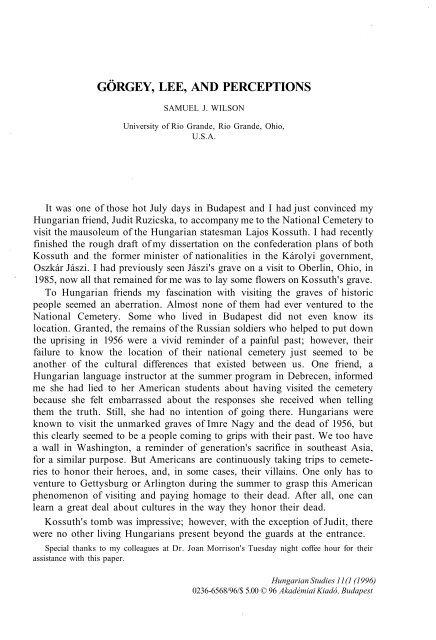HUNGARIAN STUDIES 11. No. 1. Nemzetközi Magyar ... - EPA
HUNGARIAN STUDIES 11. No. 1. Nemzetközi Magyar ... - EPA
HUNGARIAN STUDIES 11. No. 1. Nemzetközi Magyar ... - EPA
- No tags were found...
You also want an ePaper? Increase the reach of your titles
YUMPU automatically turns print PDFs into web optimized ePapers that Google loves.
GÖRGEY, LEE, AND PERCEPTIONSSAMUEL J. WILSONUniversity of Rio Grande, Rio Grande, Ohio,U.S.A.It was one of those hot July days in Budapest and I had just convinced myHungarian friend, Judit Ruzicska, to accompany me to the National Cemetery tovisit the mausoleum of the Hungarian statesman Lajos Kossuth. I had recentlyfinished the rough draft of my dissertation on the confederation plans of bothKossuth and the former minister of nationalities in the Károlyi government,Oszkár Jászi. I had previously seen Jászi's grave on a visit to Oberlin, Ohio, in1985, now all that remained for me was to lay some flowers on Kossuth's grave.To Hungarian friends my fascination with visiting the graves of historicpeople seemed an aberration. Almost none of them had ever ventured to theNational Cemetery. Some who lived in Budapest did not even know itslocation. Granted, the remains of the Russian soldiers who helped to put downthe uprising in 1956 were a vivid reminder of a painful past; however, theirfailure to know the location of their national cemetery just seemed to beanother of the cultural differences that existed between us. One friend, aHungarian language instructor at the summer program in Debrecen, informedme she had lied to her American students about having visited the cemeterybecause she felt embarrassed about the responses she received when tellingthem the truth. Still, she had no intention of going there. Hungarians wereknown to visit the unmarked graves of Imre Nagy and the dead of 1956, butthis clearly seemed to be a people coming to grips with their past. We too havea wall in Washington, a reminder of generation's sacrifice in southeast Asia,for a similar purpose. But Americans are continuously taking trips to cemeteriesto honor their heroes, and, in some cases, their villains. One only has toventure to Gettysburg or Arlington during the summer to grasp this Americanphenomenon of visiting and paying homage to their dead. After all, one canlearn a great deal about cultures in the way they honor their dead.Kossuth's tomb was impressive; however, with the exception of Judit, therewere no other living Hungarians present beyond the guards at the entrance.Special thanks to my colleagues at Dr. Joan Morrison's Tuesday night coffee hour for theirassistance with this paper.Hungarian Studies 11(1 (1996)0236-6568/96/$ 5.00 © 96 Akadémiai Kiadó, Budapest
















